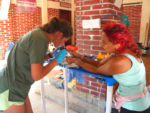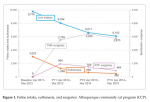Author: Canadian Animal Shelter & Community Medicine Association
-
A Why and How For Famciclovir In Kittens
Written by Dr. Michelle Meckelborg Feline Upper Respiratory infection (URI) has long been an important disease complex in shelter medicine. Historically, efforts were focused on identifying pathogens and crafting effective treatment protocols with many shelters defaulting to euthanasia to prevent spread of disease. With greater understanding of the negative effects of sheltering animals came the…
-
Advanced Surgery Options for General Practitioners
Written by Dr. Cynthia Minter CASCMA recently hosted two engaging events focused on the topic of advanced surgery for general practitioners. The first event was an informal roundtable discussion and Q&A at Toronto Humane Society attended by both shelter veterinarians and private practice veterinarians. The second event was an afternoon lecture track at the Ontario…
-
The Current Landscape of Onsite Shelter Training for Veterinarians
By Dr. Michelle Meckelborg, Shelter Veterinarian, Director of Animal Health, Maddie’s UW/UCD Shelter Medicine Fellow 2022 A survey was released in June 2024 to the CASCMA membership to better understand the roadblocks shelter’s experience with respect to veterinary training capacity. Shelters are balancing requests from students and veterinary colleagues both domestic and internationally trained to…
-
Adoptability of Cats with Periuria
By Elissa Bessonette, BSc, DVM, Graduate Certificate Shelter Medicine One of the most common behavioural concerns for cats surrendered to shelters is the issue of periuria defined as the elimination of urine in unacceptable locations outside the litter box.1 Considering the motivation behind the behaviour, periuria is separated into marking and inappropriate elimination. This distinction is…
-

Non-Surgical Sterilization using Suprelorin (Deslorelin Implant): A Practical Option for Veterinarians Serving Remote Communities
By Dr. Hannah Weitzenfeld For decades, ovariohysterectomy and castration have been the standard methods for controlling fertility in North American dogs and cats. While effective and permanent, these procedures are resource-intensive, requiring anesthesia, surgical equipment, a licensed veterinarian, and trained support staff. The Rise of Non-Surgical Contraception Recently, non-surgical contraception has gained traction as an…
-
An Accessible Canada: An Accessible Care Track at the Humane Canada Summit for Animals 2024
By Kyrsten Jade Janke Humane Canada is a particularly special conference for animal shelter and community medicine professionals. While the breadth of animal welfare topics explored by the conference is broad, the issues faced by animal welfare professionals are shared. This event brings together a individuals with varied backgrounds to share their experiences in the…
-

The ABCs of Feline Herpes
By Dr. Tracy Satchell, DVM, MS Note to Reader: This blog post has 2 parts; the first part briefly discusses the feline herpes virus and upper respiratory disease, and the second part touches on a research paper that was recently published about the isolation of gammaherpesvirus in cats. Little is known about gammaherpes in cats…
-
WHO List of Medically Important Antimicrobials
By Dr. Linda Jacobson, Toronto Humane Society/CASCMA The primary purpose of this blog is to draw readers’ attention to two documents that every veterinarian and technician should be aware of. (Yes, technicians too. Just as you have a responsibility to challenge your veterinarians on inadequate analgesia, you should challenge them on antimicrobial stewardship. Future generations…
-

Spectrum of Care – What it is and how to put it into Practice
(This blog is a summary of my notes and impressions from the excellent talks presented by Drs. Jason Stull, Michelle Evason and Jason Coe at the OVMA conference 2024, for CASCMA’s Accessible Veterinary Care track.) By Dr. Linda Jacobson, Toronto Humane Society/CASCMA What is spectrum of care? “Spectrum of care” (SpOC) is a term that…
-

‘Hacking’ Kennel Cough: Shelter Medicine Insights for our Canine Respiratory Woes
A Blog by CASCMA Board Member, Dr. Hannah Weitzenfeld, DVM Mystery US Canine Respiratory Illness With the recent apparent increase in Canine Infectious Respiratory Disease Complex (CIRDC) in community and shelter dogs across the US1, many of us are looking at what could be causing this, and how we might approach a severe outbreak in…
-
Indigenous Cultural Safety for Veterinary Teams – A Brief Introduction
By Lynn Henderson, DVM MEd CHPV, Veterinary Director, Kim & Stu Lang Community Healthcare Partnership Program at Ontario Veterinary Program, CASCMA It is a privilege to be writing this article about Indigenous cultural safety for veterinary teams; I am a non-Indigenous settler and companion animal veterinarian currently practicing community medicine alongside several First Nations in…
-
Asilomar Use in Animal Shelters
By Dr. Shelley Hutchings, Chief Veterinarian, Ottawa Humane Society and Vice-President and Vice-Treasurer, CASCMA Does your team struggle to make individual medical and behavioural case management decisions in your shelter? Is decision making time consuming, conflict causing, sometimes inconsistent, and taking an emotional toll on those that have to make these difficult decisions? If so,…
-
Keep Your Eye Out for Giant Red Kidney Worm (Dioctophyma renale) Infections in Dogs From Northern Manitoba
By Gina Bowen, DVM, Director of Veterinary Services – Winnipeg Humane Society, CASCMA Since seeing these giant prehistoric looking worms for the past 6 years or so, the excitement has died down for me, but I was reminded recently of how truly weird and wonderful these worms are when I watched the entertainment of a…
-
Review of ASPCA Position Statement on Veterinary Telemedicine
By Elissa Bessonette, B.Sc., DVM, Graduate Certificate Shelter Medicine, Calgary Humane Society Spay Neuter Lead Veterinarian, CASCMA I am not computer savvy. When there is a problem with my computer, you can be sure it’s operator error and not the equipment, but when I need to make an appointment with my doctor, I am expected…
-

Nitty Gritty on the Itty Bitties – Feline Congenital Hypothyroidism
By Dr. Tracy Satchell, Shelter Veterinarian, City of London When people find out I’m a veterinarian, I’m often asked, “What’s your favorite animal?”. I should probably say that I love all animals equally or declare that I couldn’t choose just one because I love them all! But that’s not the truth, for me the answer…
-

Supporting the Community with Pet Food Banks – What You Need to Know About Best Before Dates
Dr. Linda Jacobson, Toronto Humane Society (with grateful thanks to Kyrsten Jade Janke) Recent national survey data1 showed that 21% of pet owners struggled to access non-veterinary care during the pandemic, and the greatest need was for pet food. Companies and individuals regularly offer us donations of short-dated products, or products that are past their…
-

California Shelters Study – Harbinger for Canadian Shelters
By Dr. Michelle Meckelborg, Shelter Veterinarian, Director of Animal Health, Edmonton Humane Society Equitable public access to veterinary care is a hot button topic in the shelter and community medicinecircles. A survey recently published by the Program for Pet Health Equity out of the University ofTennessee approaches the topic from a different perspective – instead…
-
What Does a Positive PCR Really Mean? Lessons From Ringworm, Parvo, Panleukopenia And COVID-19
By Dr. Linda Jacobson, Toronto Humane Society/OSMA In the shelter, we frequently refer to Dr. Scott Weese’s diagnostic advice: “Never do a test without a (good) reason” and “Never do a test without a plan to use the result”. To this one might add: “Never do a test whose results you are unable to interpret”. This last might seem odd in…
-

Beyond “Doing Better”: Ordinal Rating Scales to Monitor Behavioural Indicators in Well-Being of Cats
By Dr. Shelley Hutchings, Chief Veterinarian at the Ottawa Humane Society Jacklyn Ellis, of Toronto Humane Society, published this article on a new tool to assess the well-being of cats in a shelter setting. This evaluation tool uses four ordinal scales to assess different behavioural aspects of a cat’s well-being. The four scales, which are…
-

Rabbit Hemorrhagic Disease: What Shelter Practitioners Need to Know
Written By: Emilia Wong Gordon, DVM, DABVP (Shelter Medicine Practice) Rabbit hemorrhagic disease (RHD) should now be on the radar of every shelter veterinarian in North America. This disease is caused by Rabbit Hemorrhagic Disease Virus 2 (RHDV2), a hardy calicivirus that resists freezing and many household disinfectants. Mortality rates in North American rabbit populations…
-

There’s No Such Thing As An Ugly Bunny! Rabbit Spay and Neuter Pearls
Blog by Dr. Linda Jacobson, Toronto Humane Society/CASCMA – material from Dr. Jennifer Farr’s talk, “Overcoming Rabbit Anesthesia and Surgery Challenges” at the September 12 CASCMA CE Day Dr. Jenn Farr, from the Hamilton/Burlington SPCA, literally knows her bunnies inside and out. She reminded us early in her talk that there’s no such thing as…
-
Positive Doesn’t Need to Be Negative: Adopting and Living With an FIV-Positive Cat
By: Dr. Linda Jacobson, President, Canadian Animal Shelter & Community Medicine Association This is a repeat of a blog Dr. Jacobson guest-wrote for the OSPCA recently. The content is mostly geared toward prospective adopters, but should be of interest to other shelter staff, including medical staff. (Photos – Toronto Humane Society). FIV stands for “feline…
-
When A Beloved Pet Dies: The Best and Worst Things to Say to People in Grief
Dr. Lianna Titcombe, BScH, DVM, CHPV As more and more animal shelters across Ontario are offering client-present euthanasia, you may find yourself having more interactions with the owners of the pets in your care. This may come with some initial worry and stress for you, but more than likely you’ll experience relief and satisfaction instead.…
-

Decreasing Barriers: An Adoption Strategy for Big Dogs in an Open Admission, Managed Intake Facility
By Dr. Esther AttardDirector, Toronto Animal Services; Board Member, CASCMA Toronto Animal Services is an open admission, managed intake facility. We have noticed animal populations on the increase when compared to 2021. In 2021 during the time period of January 1 – June 12, data reports indicate intake of 1,435 animals and in 2022, during…
-

Sun, sand, sea turtles, and surgical protocols. The ins and outs of a large volume spay/neuter campaign in Mexico
By: Natalia Hanson, Co-founder, Humane Outreach for Latin Animals Picture this: sun, sand, sea, warmth, all while helping animals and the communities where they live. Sounds lovely, doesn’t it? And it is! There’s no doubt about it, and it is one of the many perks of volunteering abroad. This blog, however, isn’t meant to be…
-

Bird Flu (Avian Influenza) and You – How Shelters Should Manage Birds During HPAI Outbreaks
Bird Flu and You – How Shelters Should Manage Birds During HPAI Outbreaks
-
High-Quality, High-Volume Spay Neuter; if you can’t beat ‘em, join ‘em!
By Dr. Tracy Satchell For many pets across the world, access to veterinary care is a luxury. A 2018 study by the Access to Veterinary Care Coalition found that over 25% of US pet owners are unable to afford basic veterinary care, such as vaccinations, parasite control, and spay/neuter [1]. In this same study, the…
-
The Rural Animal Shelter in Ontario: an Overview of Joys, Challenges and Future.
By Dr. Shalini Ramsubeik Ah, rural Ontario! The natural beauty, serenity and people are just a few reasons most of us will drive hours to go there for an escape. Two years ago, I began working at a veterinary clinic in Cavan, a rural region in Eastern Ontario. Within the first week, I began to…
-
Welcome To Being A Mini-Public Health Agency
By Dr. Linda Jacobson DVM I recently learned a new term: epistemic trespassing. “Epistemic trespassers are experts who pass judgment on questions in fields where they lack expertise.” (I don’t know the term for non-experts who pass judgment on questions in fields where they lack expertise!) We are all super-familiar with this behaviour during COVID-19.…
-
Omicron Update for Shelters: December 17, 2021
By: Linda Jacobson, DVM I wasn’t expecting to write a blog about a giant COVID wave in December 2021. Yet, here we are. I want to start by acknowledging those who have been most directly impacted by this pandemic, those who have lost loved ones, have suffered with severe illness, or continue to suffer with…
-
Veterinary Staffing Shortages – What does this mean for your shelter and pets in your community?
Shelters and rescues are also feeling the pressure from veterinary workforce staffing issues. Many shelters rely heavily on veterinary technicians and veterinary assistants for operational needs, and at the Ottawa Humane Society these positions have recently been more challenging to fill.
-
Veterinary Volunteering Abroad
By: Hanna Booth, CASCMA Board of Directors Now that the world is opening up to travel again, I’m sure many of us are craving to see somewhere new. Have you considered a vacation that incorporated some veterinary volunteering? There are many awesome animal rescue/ spay-neuter organizations around the world that are eager and grateful to…
-
Canadian Import Regulations and Animal Shelters
By Dr. Steph Black Many of us welcome the new dog importation laws with a sigh of relief knowing that it is a small step towards avoiding future atrocities like that seen in June 2020. In June of 2020 hundreds of puppies arrived from the Ukraine, some dead and many others very ill.1 This prompted…
-

Animal Control Intake of Free-Roaming Cats
Written by: Wesley Cheung, BVSc. Toronto Humane Society NACA has recently released a position statement on animal control intake of free-roaming cats. Summary: It is the position [policy] of the National Animal Care & Control Association that, at every opportunity, officers should [will] work to educate the public regarding humane and responsible co-existence and care…
-

Lifesaving Vaccines!
by Esther Attard Since the race to produce a COVID-19 vaccine began I’ve been thinking of the role vaccines play in shelter medicine. I remember a time, not that long ago, when cats would succumb to panleukopenia and dogs to parvovirus acquired during their shelter stay. It was devastating to say the least! Dogs and…
-
Cloth Face Coverings: A Non-Systematic But Hopefully Fairly Balanced Overview
July 5, 2020 There’s been a recent groundswell of support for face masks in Canada and the US. Many Ontario jurisdictions have recently mandated face coverings in public indoor settings. Quite a number of political figures in the US, who previously did not support mask-wearing, are now appearing in public wearing masks, and supporting or…
-
CASCMA Weekly COVID Briefing
Note, July 5, 2020: There’s still an enormous amount going on, but basic information is not longer changing as quickly as it was. So these briefings will become sporadic from now on and/or will be replaced by longer pieces on specific subjects. June 15, 2020 Black Lives Matter and Animal Sheltering The COVID-19 pandemic has…
-
Q&A: Can My Pet Catch or Transmit the COVID-19 Virus?
Here are answers to some common questions that shelters might be facing from their volunteers, staff and the public right now. Feel free to copy and paste if you wish. The situation is changing rapidly and this information will be updated as needed. Thank you to Dr. Scott Weese for regular updates and counsel through…
-
Stress In Family Dogs During And After COVID-19
With many families still working from home and the kids still out of school, it’s important to consider changes in routine and interrupted rest time that may affect dog behaviour. Most family dogs are used to having a fairly consistent daily routine. They get breakfast and a quick morning walk, they see the family off,…
-
Caring for Cats during COVID-19: Advice for Caregivers and Foster Parents
The COVID-19 pandemic has affected all of our lives. From illness or even tragedy among loved ones, the anxiety of not knowing what will happen next, to the boredom from staying in our homes and socially isolating, to the financial strain many of us are feeling from being unable to work, life is not the…
-
COVID-19: A Very Quick Overview for Animal Shelters
Do animal shelters need a COVID-19 plan, and why? Yes. To minimize the impact on life-saving capacity; To minimize the impact on staff; To help protect volunteers and visitors. Virologist Dr. Ian Mckay, in his excellent Virology Down Under blog, states, “China has bought us time to prepare.” We should use that time well. Staff…
-
Animal Hoarding: Can We Respond Differently?
We hear quite frequently from shelters who have confiscated or taken in large numbers of hoarded animals…. and then struggle to treat them or find them homes. These animals often have serious medical problems or are poorly socialized, or both. Providing the care they need can really strain shelter resources . This blog highlights an…
-
2020 AAFP Retrovirus Guidelines: What Do They Mean for Shelters?
(Note: This blog contains information from all the references listed below, although it focuses on the new Retrovirus Guidelines. Comments and footnotes reflect expert opinion and my own opinions.) Transmission of feline retroviruses: What do we know now? The risk of transmission of FIV between spayed or neutered cats in a normal household is very…
-
Working with undersocialized cats
By Dr. Jacklyn Ellis, PhD. For many cats, humans provide the comfort and companionship that is essential to their well-being. But for cats that have had limited exposure to people, humans are something very different. Our intentions are unclear, and we are often perceived as a threat. However, with a little patience (and a lot…
-
Medical conditions and outcomes in 371 hoarded cats
A recent scientific article authored by CASCMA’s own Dr. Linda Jacobson and published in the Journal of Feline Medicine and Surgery sheds new light on our understanding of hoarded cats in animal shelters. What was the study about? A retrospective study was conducted by analyzing medical records pertaining to hoarded cats taken in by The…
-
The value of RVTs (and why every shelter should employ them)
A recent study has confirmed what we all already know – RVTs rock! What was the study about? More scientifically speaking, the study was a survey of companion animal practices in Ontario. The goal was to evaluate the current utilization levels of veterinary technicians and the value they bring to veterinary practices. The study was…
-
Judge Rules OSPCA Act Unconstitutional
UPDATED FEBRUARY 14, 2019 The landmark January court ruling concerning the 100-year-old OSPCA Act is of paramount importance to those of us working in animal welfare. What does it mean for animal welfare and animal shelters in Ontario? Legal counsel for the case, Kurtis Andrews, and Camille Labchuk, Executive Director for Animal Justice, kindly agreed…
-
Can That Kijiji Parvo Puppy be Treated as an Outpatient?
Canine parvovirus enteritis can be an unaffordable and devastating disease for pet owners. The inability to pay for conventional in-hospital care can result in the heartbreak of relinquishment or euthanasia. Three recent studies have broken new ground by reporting the results of outpatient treatment for parvo.1–3 The justification for this approach? “We were tired of…
-

Ticks in Ontario: What Animal Shelters Should Know
[Blog updated February 2020, with thanks to Dr. Andrew Peregrine for his suggestions.] There’s a lot of ongoing hype in the media about ticks – like this cartoon that popped up on Facebook a while back. This kind of fear-mongering is concerning. It’s very reasonable to be informed, watchful and responsible, and quite another thing…
-

The Sexy Work of Saving Lives: Combined RTF and TNR Study
For many of us, getting our hands dirty in the OR is infinitely preferable to spreadsheets, graphs and statistics. However, articles like this one from New Mexico [1], detailing the successes of their community cat management program, really get the juices flowing! The jump-off point is that community cat population control is the single most…
-

Medical Care of Neonatal Kittens
Neonatal l kittens (0-2 weeks old) are our most vulnerable and fragile patients. Increasingly, shelters are able to help and save these kittens. One could reasonably make the point that “neonatal kittens are not small adult cats”! Here are some of the ways they are unique, and how we can tailor our medical care…
-
Universal canine behaviour assessments in shelters: More flaws than benefits?
* Update: Since this blog was written, the ASPCA has released a position statement on behaviour assessments for dogs in shelters. There’s growing evidence that universal canine behaviour assessments in shelters are not able to accurately assess a dog’s temperament, and are certainly unable to accurately predict how that dog may behave in a…
-
Simple ways to minimize URI: New study
This blog summarizes the findings of an important new study on feline URI in shelters. The study investigated the incidence of URI at nine shelters and analyzed the factors associated with incidence. Executive summary URI rates in cats can be substantially reduced by using simple strategies. The most significant protective factors were providing >…
-

Canine Influenza in Ontario: What Shelters Should Know
UPDATED MAY 21, 2018 The most recent Worms & Germs Blog on canine influenza states that no new cases were identified in Ontario in April and May. This means that there is no longer a threat of spread from the cases introduced into the province earlier this year. Canine influenza has therefore been eradicated from…
-
Treatment of Demodex and Other Mites: Finally, a Magic Bullet?
Historically, canine demodicosis has been a difficult and frustrating condition to treat. As recently as 2013, the leading veterinary dermatology textbook, Small Animal Dermatology, stated that, despite a good prognosis with appropriate treatment, cure “may take nearly a year”. The need to titrate ivermectin, avoid its use in susceptible breeds, deal with occasional but alarming adverse…
-
Treatment of bacterial CIRDC, URI and pneumonia in dogs and cats: 2017 Guidelines
The 2017 Antimicrobial Use Guidelines for Treatment of Respiratory Tract Disease in Dogs and Cats1 cover acute and chronic bacterial upper respiratory infections in dogs and cats, as well as bronchitis, pneumonia and pneumothorax. They include recommendations for first-line treatment for the different syndromes, as well as doses and information about antibiotic options. The full…
-
But that Famvir dose is so high! Another look at famciclovir and feline herpes
There’s been a lot of interest in our blog about the optimal famciclovir (Famvir) dose for feline herpesvirus. It’s lovely to have a dose that’s backed up by research – after all, anyone can claim success for any dosage regimen at all in a disease that’s usually self-limiting! BUT, the pharmacokinetically optimal dose (90mg/kg BID) is…
-
Links: New Book: Every Nose Counts, and more
WHAT’S OUT THERE IN SHELTER MEDICINE THIS MONTH? SHELTER METRICS, INTAKE PROCEDURES, HEARTWORM AND MORE Shelter data – new resource: Accurate data, appropriately presented, saves lives – by harnessing energies in the right direction and by attracting donors. Dr. Janet Scarlett, the inaugural Director of Shelter Medicine and a distinguished veterinary epidemiologist, has teamed…
-
Low perioperative mortality in a high-volume spay and neuter clinic
I was asked recently what would be considered an acceptable complication rate for a high-quality-high-volume spay and neuter (HQHVSN) clinic. That’s an excellent question and it’s important that we have benchmarks for these rates. The complication that keeps us awake at night is, of course, perioperative mortality. A new article reports mortality rates in 113,906…
-
Is a single vaccine useful? Should that one rabies vaccine be a 1-year or 3-year?
This question came our way a few months ago: “Two city council members are challenging our TNR program. Specifically they are criticizing the fact that we don’t booster the 3-yr rabies vaccine after 1 yr as recommended by the AVMA. We’re working on our response but frankly all the recommendations from the USDA label to…
-
Comparing FeLV/FIV point-of-care tests: Which is most accurate and why that matters
A new study compared four point-of-care tests for FeLV and FIV from IDEXX, Witness, Anigen and VetScan. These tests are often the only test used for retroviruses in cats, given the lack of good “gold standard” confirmatory tests. Shelters may euthanize cats that test positive, or, for those that adopt out positive cats, a positive…
-
No need to give kittens corn syrup post-op?
It’s common practice to apply corn syrup to the oral mucosa of kittens after pediatric surgery. The ASV spay/neuter guidelines state that this practice “may” be beneficial. but up until now we haven’t really known if it is or isn’t. Logically, kittens would seem to be at risk of hypoglycemia after a period of fasting, and…
-
Topical treatment for ringworm: New study points to more flexible treatment options
A new study compares the efficacy of commercially available topical antifungal products against ringworm spores. It’s important to emphasize, as the author did in the discussion, that this was not a clinical study and results may or may not reflect what happens in infected cats in a clinical setting. The study also did not address the…
-
PCR for diagnosing ringworm: New study
This new study from the Toronto Humane Society compared fungal culture and PCR results before treatment in 132 cats (28 positive on fungal culture and 92 negative) and during treatment in 17 positive cats. Before treatment, the sensitivity of PCR was 100% and specificity was 88.5%. In other words, a negative result was extremely reliable but there were…
-
Links: Canine Behaviour Evaluations Pointless? and More
WHAT’S OUT THERE IN SHELTER MEDICINE THIS MONTH? Click the links for more: No better than flipping a coin: Why behaviour evaluations in shelters are fundamentally flawed Temporary CVO accreditation for rabies vaccination clinics Animal transport webinars by the ASPCA: Vaccinations, funding and goals Ensuring a safe journey How to transport cats What to do…
-
Still Fighting for Positive Change: Canada Shelter Stats 2015
The Canadian Federation of Humane Societies’ Shelter Statistics Report 2015 (1) undoubtedly contains good news. The survey covers only humane societies and SPCAs, i.e. many other groups are not included, but it still provides the best data we have for Canada. From the fluctuations in the data tables over the years, we also need to take these…
-
Famvir dose for cats with herpes: New study findings
Famciclovir (Famvir) has been around for a while as a treatment for feline herpesvirus infection. Until now, though, we haven’t really known how much to use, or how often. A new study has some answers. First, though – when should we consider using Famvir? It’s not always straightforward. If there is severe stress and overcrowding,…
